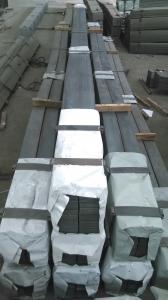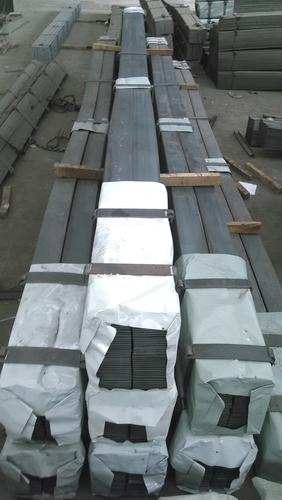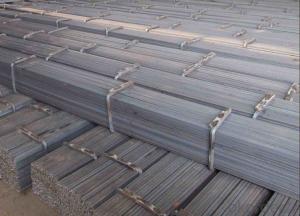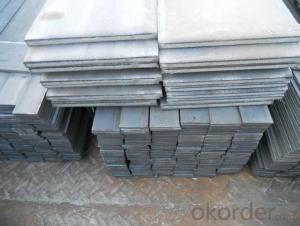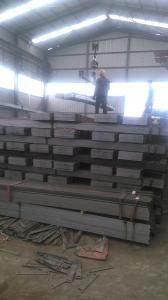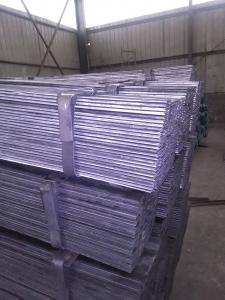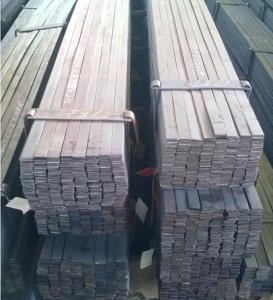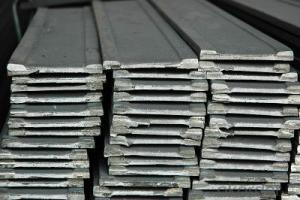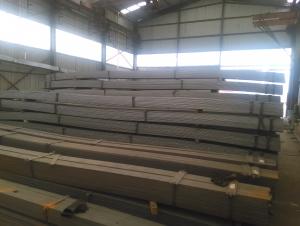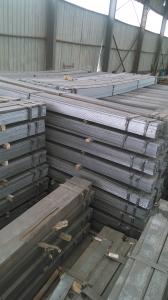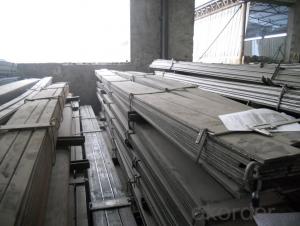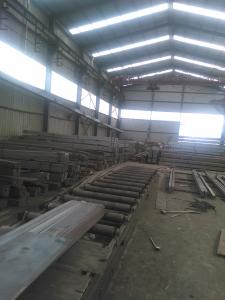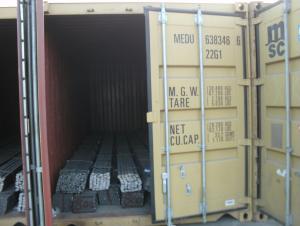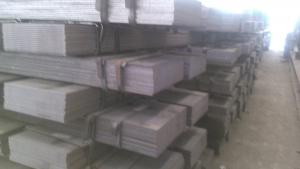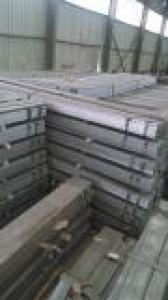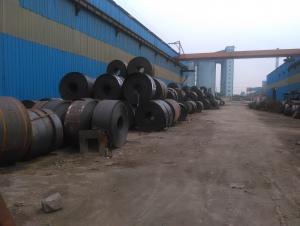Steel Flat Bar Grade JIS SS400 B Added
- Loading Port:
- Tianjin
- Payment Terms:
- TT or LC
- Min Order Qty:
- 50 m.t.
- Supply Capability:
- 10000T m.t./month
OKorder Service Pledge
OKorder Financial Service
You Might Also Like
Product Description:
OKorder is offering Steel Flat Bar Grade JIS SS400 B Added at great prices with worldwide shipping. Our supplier is a world-class manufacturer of steel, with our products utilized the world over. OKorder annually supplies products to African, South American and Asian markets. We provide quotations within 24 hours of receiving an inquiry and guarantee competitive prices.
Product Applications:
Steel Flat Bar Grade JIS SS400 B Added are ideal for structural applications and are widely used in the construction of buildings and bridges, and the manufacturing, petrochemical, and transportation industries.
Product Advantages:
OKorder's Steel Flat Bar Grade JIS SS400 B Added are durable, strong, and wide variety of sizes.
Main Product Features:
· Premium quality
· Prompt delivery & seaworthy packing (30 days after receiving deposit)
· Can be recycled and reused
· Mill test certification
· Professional Service
· Competitive pricing
Product Specifications:
Manufacture: slited
Slitting precision (width) : 0.5 mm or less
Raw material: Q235B, Q345B, Q235-1 b
crosscutting precision (length) : 2 mm or less
Processing: the thickness of 2.0-16 mm;
Shear length: 2000 mm above
Wide degree: 15-1250 - mm;
Leveling precision: 1-2 MM square
Packaging: Export packing, nude packing, bundled
FAQ:
Q1: How many tons of steel products could be loaded in containers?
A1: Usually the steel products are delivered by bulk vessel because of the large quantity and the freight. However, there are no bulk vessel enter some seaports so that we have to deliver the cargo by containers. The 6m steel product can be loaded in 20FT container, but the quantity is changed according to the size, usually from 18tons to 25tons.
Q2: what is the difference between actual weight and theoretical weight?
A2: All the section steel has two weights: actual weight and theoretical weight. Actual weight is the weighing out when the product delivered from the mill. Theoretical weight is calculated by pieces. The invoice can be based on each of them as your request.
Q3: How soon can we receive the product after purchase?
A3: Within three days of placing an order, we will arrange production. The normal sizes with the normal grade can be produced within one month. The specific shipping date is dependent upon international and government factors, the delivery to international main port about 45-60days.
Images:
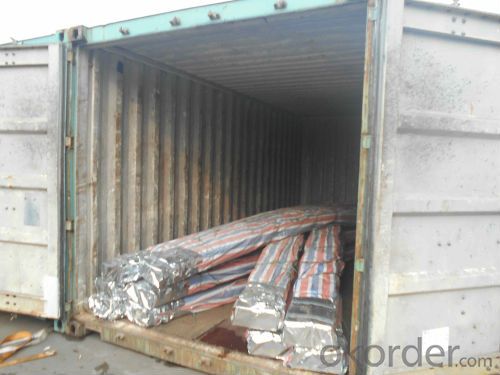
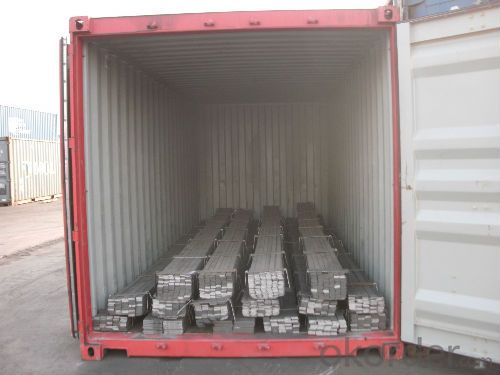
- Q: What are the common welding methods used for steel flat bars?
- The common welding methods used for steel flat bars are MIG (Metal Inert Gas) welding, TIG (Tungsten Inert Gas) welding, and stick welding (Shielded Metal Arc Welding).
- Q: How do steel flat bars compare to other forms of steel like angles or channels?
- Steel flat bars, angles, and channels are all popular forms of steel used in various industries and applications. While they all share the same material, they differ in their shape and structural properties. Steel flat bars are rectangular in shape, with a flat surface and parallel edges. They are commonly used for structural support, fabrication, and construction projects. One of the key advantages of steel flat bars is their versatility. They can be easily cut, drilled, and welded, making them ideal for creating custom shapes and structures. Additionally, their flat surface allows for easy attachment of other components. On the other hand, steel angles are L-shaped, with two legs that meet at a 90-degree angle. This unique shape provides excellent structural strength and stability, making them suitable for applications where load-bearing capacity is crucial. Steel angles are commonly used in construction, framing, and reinforcement projects. They are often used to provide additional support and stability to structures or to create corners and edges. Steel channels, also known as C-channels or U-channels, have a U-shaped cross-section with two parallel sides and a base. They are widely used in construction, manufacturing, and electrical industries. Steel channels offer high strength and rigidity, making them suitable for applications requiring load-bearing capabilities. They are often used in building frames, support systems, and as structural components in machinery. In terms of comparison, each of these steel forms has its own advantages and applications. Steel flat bars offer versatility and ease of fabrication, making them suitable for a wide range of projects. Steel angles provide excellent structural strength and stability, making them ideal for load-bearing applications and creating corners. Steel channels offer high rigidity and are commonly used in construction and manufacturing industries. Ultimately, the choice between steel flat bars, angles, or channels depends on the specific requirements of the project. Factors such as load-bearing capacity, structural stability, and ease of fabrication should be considered when deciding which form of steel is most suitable.
- Q: Do steel flat bars have a specific tolerance range?
- Yes, steel flat bars do have a specific tolerance range. Tolerance refers to the acceptable deviation from the specified dimensions or properties of a product. In the case of steel flat bars, the tolerance range typically includes variations in thickness, width, and length. The specific tolerance range may vary depending on the manufacturing standards, grade of steel, and intended application of the flat bars. These tolerances are important to ensure the flat bars meet the required specifications and can be effectively used in various construction and industrial applications.
- Q: Can steel flat bars be used as structural support in buildings?
- Steel flat bars can indeed serve as structural support in buildings. They are widely employed in construction owing to their impressive strength and longevity. Their versatility allows them to be utilized in beams, columns, and braces, among other applications. With their exceptional load-bearing capacity, steel flat bars can withstand substantial burdens, making them ideal for building structures. Furthermore, their consistent shape and size facilitate easy integration into construction projects. All in all, steel flat bars are a dependable option for delivering structural support in buildings.
- Q: How to determine the application direction of steel grid plate
- This order must be strict and clear. The steel grid plate in the length direction (flat length direction) on at both ends of a supporting beam, i.e. use or the use of slot, and ends in the width direction can not need support. Because the bearing capacity of steel plate mainly from the flat direction. For example drain cover
- Q: What are the different types of defects that can occur in steel flat bars during manufacturing?
- Some common defects that can occur in steel flat bars during manufacturing include surface cracks, internal voids or inclusions, dimensional variations, and uneven surface finish.
- Q: What is the quota for the flat steel used in the lightning belt -40*4?
- Fixed the lightning belt installation "is based on the 8 mm galvanized steel park system, you can make the material conversion and adjustment.
- Q: Galvanized steel flat welding occurs after the material itself crack.
- Cold crack: a cold crack is a weld crack that occurs when the joint is cooled to a lower temperature. The causes are the quenching tendency, the residual stress, the diffusion hydrogen content of the weld metal and the heat affected zone.
- Q: Can steel flat bars be used for making hand tools or gardening equipment?
- Yes, steel flat bars can be used for making hand tools or gardening equipment. Steel is a strong and durable material, making it suitable for various applications in tool and equipment manufacturing.
- Q: Can steel flat bars be used in agricultural applications?
- Yes, steel flat bars can be used in agricultural applications. Steel flat bars are versatile and have several properties that make them suitable for use in the agricultural industry. Firstly, steel flat bars are known for their strength and durability. They can withstand heavy loads and provide structural support, making them ideal for agricultural equipment such as trailers, plows, and cultivators. Additionally, steel flat bars are resistant to corrosion, which is crucial in agricultural settings where exposure to moisture, chemicals, and fertilizers is common. This resistance ensures the longevity of the equipment and reduces maintenance costs. Furthermore, steel flat bars are highly malleable, which allows for easy fabrication and customization. They can be bent, cut, or welded to meet specific requirements and design needs. This flexibility makes them suitable for various agricultural applications, such as constructing fences, gates, and animal enclosures. Overall, the strength, durability, corrosion resistance, and malleability of steel flat bars make them a reliable choice for agricultural applications. They provide the necessary support, withstand harsh conditions, and are easily adaptable to different agricultural requirements.
Send your message to us
Steel Flat Bar Grade JIS SS400 B Added
- Loading Port:
- Tianjin
- Payment Terms:
- TT or LC
- Min Order Qty:
- 50 m.t.
- Supply Capability:
- 10000T m.t./month
OKorder Service Pledge
OKorder Financial Service
Similar products
Hot products
Hot Searches
Related keywords
